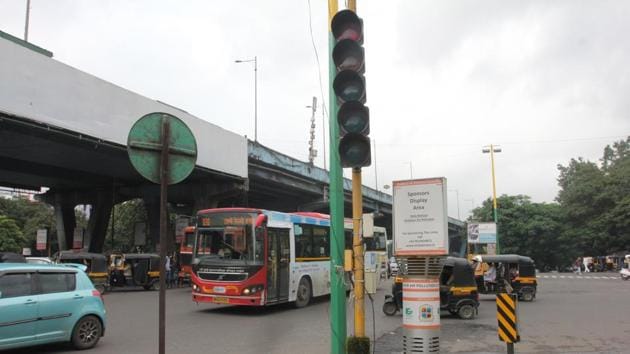Check the feasibility of blue traffic lights: HC to Maha pollution board
According to the idea, an additional blue light should blink for 10 seconds after the red light comes on, and blink again for 10 seconds before the light turns green.
The Bombay high court (HC) and the environment department have directed the Maharashtra Pollution Control Board (MPCB) to check the feasibility of “blue traffic light” at signals to indicate to drivers to turn off their engines in a bid to reduce air pollution.

The concept of the blue traffic light was suggested by Ghatkopar residents Shivani Khot, 20, and her sister, Esha, 15 in 2018 that won the National level gold medal at the National level All India Universities Anveshan Research Convention 2018 representing Mumbai Univeristy, and the idea was also selected in the top 20 projects of the International Sustainability Challenge (ISC) of Indian Institute of Technology-Bombay’s Techfest last year. Subsequently, they presented their concept before various state departments at the National Conference ‘Clean Air Mission Maharashtra’ last year.
According to the idea, an additional blue light should blink for 10 seconds after the red light comes on, and blink again for 10 seconds before the light turns green. The first blinking light would indicate to drivers to switch off their engines, and the second to turn the engines back on. Hindustan Times reported about the idea on November 18, 2019.
Over the past year, the sisters presented this concept to several state and central agencies, before writing to Maharashtra government and the HC in December 2019, requesting a test-run for the concept.
The HC registrar last week (on Friday) asked the Maharashtra environment department to look into the application “appropriately in accordance with law”. The environment department on Wednesday further directed MPCB to study the concept and file a report. HT has reviewed the letters issued by the HC and the environment department.
“This can be implemented on a trial basis or a pilot study to record the drop in traffic emissions. The concept can be implemented at a cost of ₹8,500 for each junction while the carbon savings will be much more, and a huge benefit to society,” Shivani said on Wednesday, when asked about the order.
“There is no major infrastructural change needed. The installation of a small bright blue blinking retrofitted light next to existing traffic signals followed by guidelines and awareness programme,” Esha added.
Traffic signals are a major source for emissions because drivers keep engines switched on during red lights, leading to the release of half combusted gases, such as nitrogen dioxide and particulate matter, which are harmful to human health, according to Centre for Science and Environment (CSE), New Delhi
The sisters, along with an independent expert, carried out an assessment of vehicular idling at a traffic junction in Ghatkopar, where they calculated that 156 litres of fuel was wasted per day while 371 kg of carbon dioxide was being emitted over 24 hours at just that one spot (Jijamata Chowk).
“This is important concept and needs to be implemented. Vehicular idling is one of the highest emission sources from overall emissions coming from vehicles. When vehicles are idling at traffic junctions they emit twice as many pollutants as compared to on-road emissions. Not only emissions, it is also a huge fuel guzzler and demands special attention through concepts like this,” said Anumita Roy Chowdhury, executive director (research and advocacy), CSE.
MPCB said it has written to the transport department to understand the concept’s impact on the headway (measurement of the distance or time between vehicles in transit approaching a signal) or frequency between vehicles that are stationary versus oncoming vehicles towards each signal. “But we have not heard from them yet,” said Sudhir Srivastava, chairman, MPCB.
There is also some scepticism about the concept. Priyank Bharti, joint secretary, in the Union ministry of road transport and highways said: “There is a probability of a burst of higher emissions when vehicle engines are switched on in one go at traffic junctions, as compared to the amount of fuel or carbon dioxide saved through this concept. There are several issues that need to be considered before implementing a massive infrastructural change across all traffic junctions. However, we are open to the idea and would like to review the concept.”
An official from the Maharashtra transport department said such decisions are usually pan-India, and are only taken by the Centre.
The Petroleum Conservation Research Association (PCRA) under the Union petroleum and natural gas ministry. said they was a similar awareness campaign already underway. “Changing infrastructure at traffic lights across the country is a tedious exercise. Under our campaign underway in New Delhi, commuters have been asked to switch off engines at any traffic light more than 20 seconds. This campaign will be soon be extended across other megacities too,” said Rajiv Khanna, director and head of department (transport), PCRA.
“Carbon dioxide emission from idling was calculated to be 25,000 tons per year in New Delhi according to a PCRA study,” argued Shivani, adding: “PCRA’s campaign is taken up only for a few months but we need a longterm sustainable solution that increases deterrence at traffic junctions.”
Stay updated with all the Breaking News and Latest News from Mumbai. Click here for comprehensive coverage of top Cities including Bengaluru, Delhi, Hyderabad, and more across India along with Stay informed on the latest happenings in World News.
Stay updated with all the Breaking News and Latest News from Mumbai. Click here for comprehensive coverage of top Cities including Bengaluru, Delhi, Hyderabad, and more across India along with Stay informed on the latest happenings in World News.






